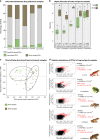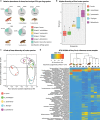Skin bacterial diversity of Panamanian frogs is associated with host susceptibility and presence of Batrachochytrium dendrobatidis
- PMID: 26744810
- PMCID: PMC4918441
- DOI: 10.1038/ismej.2015.234
Skin bacterial diversity of Panamanian frogs is associated with host susceptibility and presence of Batrachochytrium dendrobatidis
Abstract
Symbiotic bacteria on amphibian skin can inhibit growth of the fungus Batrachochytrium dendrobatidis (Bd) that has caused dramatic population declines and extinctions of amphibians in the Neotropics. It remains unclear how the amphibians' skin microbiota is influenced by environmental bacterial reservoirs, host-associated factors such as susceptibility to pathogens, and pathogen presence in tropical amphibians. We sampled skin bacteria from five co-occurring frog species that differ in Bd susceptibility at one Bd-naive site, and sampled one of the non-susceptible species from Bd-endemic and Bd-naive sites in Panama. We hypothesized that skin bacterial communities (1) would be distinct from the surrounding environment regardless of the host habitat, (2) would differ between Bd susceptible and non-susceptible species and (3) would differ on hosts in Bd-naive and Bd-endemic sites. We found that skin bacterial communities were enriched in bacterial taxa that had low relative abundances in the environment. Non-susceptible species had very similar skin bacterial communities that were enriched in particular taxa such as the genera Pseudomonas and Acinetobacter. Bacterial communities of Craugastor fitzingeri in Bd-endemic sites were less diverse than in the naive site, and differences in community structure across sites were explained by changes in relative abundance of specific bacterial taxa. Our results indicate that skin microbial structure was associated with host susceptibility to Bd and might be associated to the history of Bd presence at different sites.
Figures




Similar articles
-
The Skin Microbiome of the Neotropical Frog Craugastor fitzingeri: Inferring Potential Bacterial-Host-Pathogen Interactions From Metagenomic Data.Front Microbiol. 2018 Mar 20;9:466. doi: 10.3389/fmicb.2018.00466. eCollection 2018. Front Microbiol. 2018. PMID: 29615997 Free PMC article.
-
Composition of symbiotic bacteria predicts survival in Panamanian golden frogs infected with a lethal fungus.Proc Biol Sci. 2015 Apr 22;282(1805):20142881. doi: 10.1098/rspb.2014.2881. Proc Biol Sci. 2015. PMID: 25788591 Free PMC article.
-
Inhibition of Batrachochytrium dendrobatidis Infection by Skin Bacterial Communities in Wild Amphibian Populations.Microb Ecol. 2021 Oct;82(3):666-676. doi: 10.1007/s00248-021-01706-x. Epub 2021 Feb 18. Microb Ecol. 2021. PMID: 33598748
-
Mitigating amphibian chytridiomycosis with bioaugmentation: characteristics of effective probiotics and strategies for their selection and use.Ecol Lett. 2013 Jun;16(6):807-20. doi: 10.1111/ele.12099. Epub 2013 Mar 3. Ecol Lett. 2013. PMID: 23452227 Review.
-
Review of the Amphibian Immune Response to Chytridiomycosis, and Future Directions.Front Immunol. 2018 Nov 9;9:2536. doi: 10.3389/fimmu.2018.02536. eCollection 2018. Front Immunol. 2018. PMID: 30473694 Free PMC article. Review.
Cited by
-
Unveiled feather microcosm: feather microbiota of passerine birds is closely associated with host species identity and bacteriocin-producing bacteria.ISME J. 2019 Sep;13(9):2363-2376. doi: 10.1038/s41396-019-0438-4. Epub 2019 May 24. ISME J. 2019. PMID: 31127178 Free PMC article.
-
Temporal Variation of the Skin Bacterial Community and Batrachochytrium dendrobatidis Infection in the Terrestrial Cryptic Frog Philoria loveridgei.Front Microbiol. 2017 Dec 22;8:2535. doi: 10.3389/fmicb.2017.02535. eCollection 2017. Front Microbiol. 2017. PMID: 29312226 Free PMC article.
-
The Skin Microbiome of the Neotropical Frog Craugastor fitzingeri: Inferring Potential Bacterial-Host-Pathogen Interactions From Metagenomic Data.Front Microbiol. 2018 Mar 20;9:466. doi: 10.3389/fmicb.2018.00466. eCollection 2018. Front Microbiol. 2018. PMID: 29615997 Free PMC article.
-
Using "Omics" and Integrated Multi-Omics Approaches to Guide Probiotic Selection to Mitigate Chytridiomycosis and Other Emerging Infectious Diseases.Front Microbiol. 2016 Feb 2;7:68. doi: 10.3389/fmicb.2016.00068. eCollection 2016. Front Microbiol. 2016. PMID: 26870025 Free PMC article. Review.
-
Characterization of the Skin Cultivable Microbiota Composition of the Frog Pelophylax perezi Inhabiting Different Environments.Int J Environ Res Public Health. 2021 Mar 5;18(5):2585. doi: 10.3390/ijerph18052585. Int J Environ Res Public Health. 2021. PMID: 33807539 Free PMC article.
References
-
- Becker MH, Richards-Zawacki CL, Gratwicke B, Belden LK. (2014). The effect of captivity on the cutaneous bacterial community of the critically endangered Panamanian golden frog (Atelopus zeteki. Biol Conserv 176: 199–206.
-
- Becker MH, Walke JB, Murrill L, Woodhams DC, Reinert LK, Rollins-Smith LA et al. (2015. a). Phylogenetic distribution of symbiotic bacteria from Panamanian amphibians that inhibit growth of the lethal fungal pathogen Batrachochytrium dendrobatidis. Mol Ecol 24: 1628–1641. - PubMed
MeSH terms
LinkOut - more resources
Full Text Sources
Other Literature Sources

